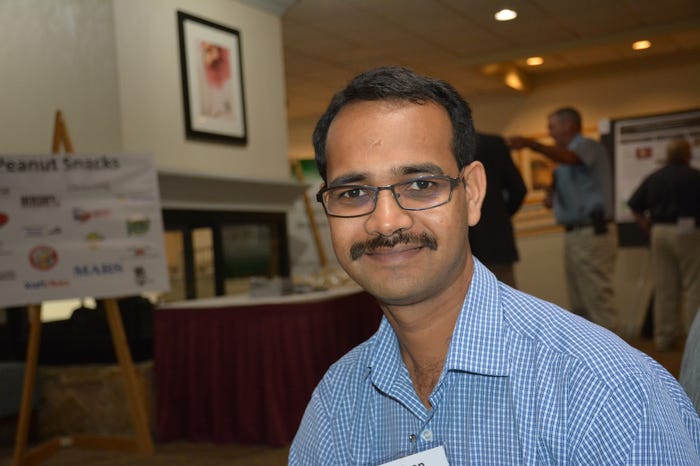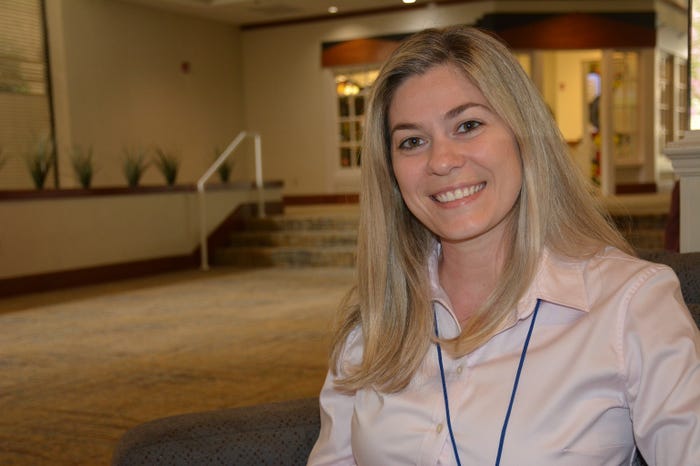
Charles Simpson has missed one of the 49 annual meetings of the American Peanut Research and Education Society. He was ill in 1973. Sudheep Bag is attending his first after joining the University of Georgia as a crop virologist in March.
The two represent the history and the future of an organization that for a half century has helped U.S. peanut farmers achieve better yields and quality and produce more efficiently.
Simpson, a Texas AgriLife research plant breeder at Stephenville, Texas, was instrumental in ushering APRES out of the Peanut Information Working Group into the American Peanut Research and Education Association and then to its current standing as a Society.
His contributions have been legion and monumental, including collection and identification of numerous wild peanut species from South America and ongoing work to trace the current commercial peanut to its origins.
“APRES has been the lifeblood of the peanut industry since its beginning,” Simpson said, following presentations at the opening session of the 50th annual meeting, held in historic Williamsburg, Va., near what is considered to be the first field where peanuts were cultivated in the United States.
Simpson says APRES’ creation coincided with new peanut varieties, including Star, that, from 1967 through 1969, was planted on more U.S. acres than any other peanut ever had been.
In his career, Simpson added to the list of new cultivars. But he says the “yield explosion” evident over the past five decades comes from more than better varieties. “Herbicides, including Treflan, that came along in the late 1960s created the yield spike,” he says.
Cooperation
The cooperation between disciplines — entomology, pathology, agronomy, engineering — was a fundamental factor as well. “We stacked all that onto the world of plant breeders,” he adds, and production soared.
He says in the early days, plant breeders were more open to exchange ideas freely. “Plant patents changed that,” he says, “but we still learn a lot from each other.”
Sudheep Bag says he hopes to learn much from the experienced scientists who attend APRES and hopes to contribute to the volume of knowledge the organization has fostered over the years.
He says virus-transmitted diseases have concerned peanut producers and research scientists for decades. “The focus has been on how to manage diseases, such as tomato spotted wilt virus (TSWV). I want to concentrate on the virus, learn how it interacts with the host. Past efforts have been geared toward management, but we do not have control.”
He hopes to contribute by finding control options.
Rick Brandenburg, professor at North Carolina State University and the new APRES president, says APRES provides a venue for peanut scientists “to get together and bounce ideas off each other. Most everyone (in peanut research) is here. It’s a good opportunity to see what they are doing in other areas and then take ideas back home and consider how they will work.”
He says one of the strengths of the organization is intimacy. “We know almost everyone; we know who will be here.” He says the organization is small enough to know the members, but large enough to offer multi-disciplined approaches to production challenges.
“Almost everybody knows everybody; there is a tangible value in that.”
Opens Doors
Christiane Pilon, a University of Georgia peanut physiologist at Tifton, is attending her second APRES meeting. “Last year, I had been with UGA only three months and everyone said I should attend APRES.”
She went to the meeting in Albuquerque and presented a paper for a colleague with whom she had collaborated, but who was unable to attend.
“After the presentation, a lot of people came up to talk to me,” she says. “It opened a lot of doors. I learned a lot, too, about all kinds of research from other APRES members.
“I was excited to come back this year and brought several student (advisees) with me.”
Pilon, a native of Brazil, earned a PhD from the University of Arkansas and now works mostly on peanut stresses — drought and chemical issues, among others.

John Beasley has missed two APRES meetings since 1980. Beasley is professor and head of the department of crop, soil and environmental sciences at Auburn University, but spent 30 years as Extension peanut specialist at the University of Georgia.
He says the economics of peanuts makes APRES more than relevant. “Compared to other crops, peanuts, with 1.7 to 1.8 million acres, is a minor crop,” he says. “But to the states that grow peanuts, it’s an important economic factor.”
APRES brings scientists together to take on the production challenges peanut farmers face, he says. “Tomato spotted wilt is not just a Southeast problem,” Beasley explains. “It goes all the way out to Texas.”
APRES researchers have studied the disease and developed management strategies.
“Leaf spot is another common issue across the board,” Beasley says. “APRES is a place where we share ideas since most challenges are not isolated to one region.
The cooperation among scientists is key, he adds. “I’ve never seen a more collaborative group than APRES. Peanut scientists are open and willing to cooperate, share ideas and solve problems. We are interested in learning what we can do to produce peanuts more efficiently.”
Dan Anco, Clemson University Extension peanut specialist at Blackville, S.C., says, “APRES is the peanut butter that bonds the industry together. The flavor comes from the people who come together here.”
He says the organization’s single-minded focus offers opportunities for researchers, even relatively new ones, to learn much from the annual meeting. He’s attended three.
Anco says the 50th meeting provided a unique perspective with a look back at the history and forward to the future of APRES and the peanut industry.

History Lesson
K. L. Beasley, a doctoral candidate in history at Florida State University and daughter of John Beasley, set the stage for the 50th annual meeting with a look back at key APRES milestones, dating back to 1957 and the initiation of the Peanut Information Working Group.
She credited peanut research pioneers for their foresight. Frank McGill, Joe Suggs and Charles Simpson, among others, she said, saw a need to bring the top scientists together to improve peanut yields. An early goal was to double average yields, which at the time was less than 1,000 pounds per acre.
Early research targets included narrow-row peanut production and aflatoxin.
Beasley, who attended numerous APRES meetings with her father, said the organization has long been “family oriented. The first program for spouses was developed in 1979.”
She said including graduate students into the organization helped build on the work of early researchers.
“Today, the graduate students are the future of APRES,” she said.
Simpson agrees. “APRES is still the lifeblood of the peanut industry,” he says.
About the Author(s)
You May Also Like






